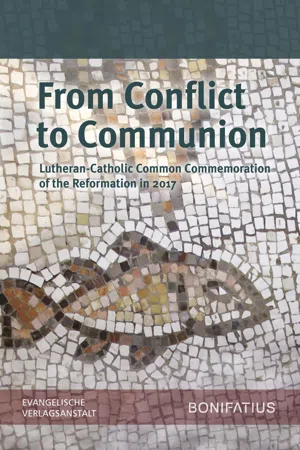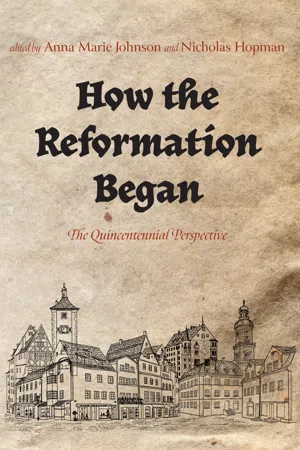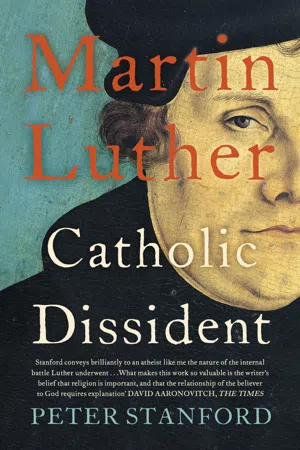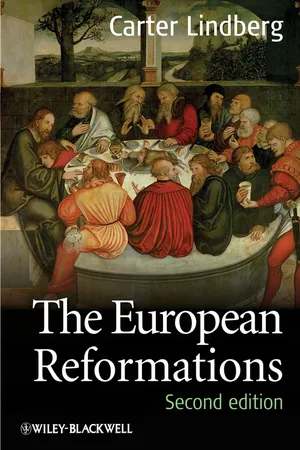History
Diet of Worms
The Diet of Worms was a historic assembly held in 1521 in the city of Worms, Germany. It is most famous for the trial of Martin Luther, where he was called to recant his teachings that opposed the Catholic Church. Luther's refusal to recant led to his excommunication and the start of the Protestant Reformation.
Written by Perlego with AI-assistance
Related key terms
7 Key excerpts on "Diet of Worms"
- eBook - ePub
A Reformation Life
The European Reformation through the Eyes of Philipp of Hesse
- David M. Whitford(Author)
- 2015(Publication Date)
- Praeger(Publisher)
Chapter 31521—The Diet of Worms : Martin Luther and the Beginning of the ReformationA Momentous Diet
Charles von Hapsburg, Duke of Burgundy, Duke of Austria, and king of Spain was elected Holy Roman emperor in Frankfurt on June 28, 1519. It took time to organize his coronation, which took place—according to ancient tradition—in the city of Aachen on October 26, 1520. His entry into Aachen was a grand event, with hundreds of mounted knights, archers, foot soldiers, and magnificently clothed courtiers. He took an oath that day to defend the empire and his Christian faith. Almost as soon as the ceremonies were over, he announced that he would soon gather together an imperial parliament to meet in the central German city of Worms. These imperial parliaments were called diets after the Latin word dies or day, for a general meeting day of the empire. As Charles left Aachen for the journey to Worms, he sent summonses to all the great nobles and prelates of the empire.Philipp of Hesse, who would have turned sixteen about the time the summons arrived, surely greeted it with excitement. Like Charles, it would be Philipp’s first diet. Also like Charles, he intended to make an impression when he arrived. Philipp arrived in Worms in late January 1521 guided by more than four hundred armed knights and soldiers. Philipp would attend nearly every major diet of the empire for the next forty years. The Diet of Worms, however, is not remembered today because it was the first diet attended by either Charles or Philipp or because it was to deal with the increasing threat from Turkish armies. Five hundred years later, the Diet of Worms is remembered because of the presence of a single man born to commoner parents: Martin Luther.Martin Luther (1483–1546)
According to his mother, Martin Luther was born in Eisleben in Saxony, late in the evening of November 10, 1483. Early the next morning, he was taken (probably by the women who aided his mother) to the closest church, the Church of Saints Peter and Paul, where he was baptized and named in honor of Saint Martin of Tours. His parents were Hans (d. 1530) and Margaretta (d. 1531) Lüder. When Martin changed his last name to Luther is unclear, though he continued to use Lüder as late as 1508. His father was a miner in Eisleben, but soon after Martin was born, Hans moved the family to Mansfeld in the hopes of earning a better living. Throughout his life, Luther would consider Mansfeld his hometown. It was a small city and Hans’s hope of finding prosperity there turned out to be well founded, for he became a rather successful copper miner and ore smelter there. His increasing wealth allowed him to enroll young Martin, his eldest son, in a Latin school in town in 1491, when Martin was seven. Over the next ten years, Martin continued his primary and secondary education. For a time he went to school in Magdeburg, then finished his studies in Eisenach, where he roomed with relatives. - eBook - ePub
Fallible Heroes
Inside the Protestant Reformation
- Stephen Fortosis, Harley T. Atkinson(Authors)
- 2022(Publication Date)
- Wipf and Stock(Publisher)
5Luther
Diet at Worms and the Wittenberg Crisis—Roland Bainton“On the sixteenth of April, Luther entered Worms in a Saxon two-wheeled car with a few companions. The imperial herald preceded, wearing the eagle upon his cloak. Although it was the dinner hour, two thousand turned out to conduct Luther to his lodging. On the following day at four o’clock Luther was waited upon by the herald and the imperial marshal, who conducted him furtively, to avoid the crowds, to a meeting of the emperor, the electors, and a portion of the estates. The monk stood before the monarch, who exclaimed, ‘That fellow will never make a heretic of me.’”161“—V. H. H. GreenThe Diet of Worms might well appear as the climacteric of Luther’s career, and in a sense it was so, since as a result of his meeting with the Emperor Charles V the latter decided to implement the papal decision. As a result the principal secular and ecclesiastical authorities combined to stamp out the challenge to their order. The drama of the ensuing situation has so gripped the historians’ imagination that the importance of the Diet itself has been sometimes obscured.”162In 1500 , a son was born to Philip the Handsome, King of Castille. He was named Charles, and could accurately be called a prodigy. He learned to speak German, Spanish, Italian, and French; he pretended to piety but carefully studied the art of war and intrigue; he read Phillippe de Commines and learned early on the tricks of diplomacy and the immoral affairs of state. At age fifteen, he assumed the governments of Flanders, Holland, Franche Comte, and Burgundy. At age sixteen, he became Charles, King of Spain, Sicily, Sardinia, Naples, and Spanish America. When only nineteen, he aspired to be emperor and spent 850 ,000 florins to gain the office. Now he was thrust into a no-win situation regarding an “errant monk.” Having exhausted ecclesiastical means to bring Luther to his knees, the Church in Rome urged Charles V to summon the professor before a council of German leaders in Worms, Germany, in 1521 . Plans for such were on-again, off-again for six months as the parties jockeyed for acceptable conditions. Then the Church did an about-face. The pope sent Jerome Aleander to convince Charles to cancel the Diet and send Luther in chains to Rome. As Aleander journeyed to meet Charles, he was amazed to find that “nine-tenths of the Germans cried ‘Luther,’ and the other one-tenth, ‘Death to the pope.’”163 - eBook - ePub
From Conflict to Communion – Including Common Prayer
Lutheran-Catholic Common Commemoration of the Reformation in 2017 Report of the Lutheran-Roman Catholic Commission on Unity
- The Lutheran World Federation, The Lutheran World Federation(Authors)
- 2016(Publication Date)
- Evangelische Verlagsanstalt(Publisher)
54. According to the laws of the Holy Roman Empire of the German Nation, a person who was excommunicated also had to be put under imperial ban. Nevertheless, the members of the Diet of Worms required that an independent authority interrogate Luther. Thus, Luther was called to Worms and the Emperor offered Luther, now a declared heretic, a safe passage to the city. Luther had expected a disputation at the Diet, but was only asked whether he had written certain books on a table in front of him, and whether he was prepared to recant.55. Luther responded to this invitation to recant with the famous words: »Unless I am convinced by the testimony of the Scriptures or by clear reason (for I do not trust either in the pope or in councils alone, since it is well known that they have often erred and contradicted themselves), I am bound by the Scriptures I have quoted, and my conscience is captive to the Words of God. I cannot and I will not retract anything, since it is neither safe nor right to go against conscience. May God help me. Amen.«1656. In response, Emperor Charles V delivered a remarkable speech in which he set forth his intentions. The emperor noted that he had descended from a long line of sovereigns who had had always considered it their duty to defend the Catholic faith »for the salvation of souls« and that he had the same duty. The emperor argued that a single friar erred when his opinion was in opposition to all of Christianity for the last thousand years.1757. The Diet of Worms made Luther an outlaw who had to be arrested or even killed and commanded the rulers to suppress the »Lutheran heresy« by any means. Since Luther’s argument was convincing to many of the princes and towns, they did not carry out the mandate.
58.BEGINNINGS OF THE REFORMATION MOVEMENT - eBook - ePub
How the Reformation Began
The Quincentennial Perspective
- Anna Marie Johnson, Nicholas Hopman(Authors)
- 2022(Publication Date)
- Pickwick Publications(Publisher)
266CommentaryBy its origin, the Edict of Worms became a document of the crisis of church authority. With the bull Decet Romanum Pontificem Luther was expelled from the church because of heresy. This was a decision of the highest ecclesial judge, but this decision was not, as was to be expected according to the law, automatically followed by the emperor making Luther an outlaw; rather, the Saxon electoral prince demanded to “hear” Luther in Worms in order to bring the truth about him to light. Simply by doing so they called into question the authority of the Roman judgment. The frequent abuse of the heresy accusation in the Middle Ages had already contributed to this loss of authority. “After all, the exercise of ecclesiastical teaching authority was used early on as a means of fighting all kinds of opponents—for example in disputes between monks and overly free teachers, between world clergy and mendicants, between Dominicans and Franciscans and within the mendicant orders.”267 The papal nuncio Aleander wrote in a letter on February 8 , 1521 : “But now all Germany is in great turmoil; nine tenths are raising the field cry ‘Luther!,’ and for the remaining tenth, if they are indifferent to Luther, the slogan is at least: ‘Death to the Roman court!’”268 Even though this may be exaggerated, the mere fact that so many people shared Luther’s ideas, which the Roman magisterium had declared to be heretical, demonstrates how many had emigrated from the domain of papal authority. Under these circumstances it would not lead to conflict resolution simply to appeal or refer to papal authority. Thus, many participants of the Diet in Worms were in favor of offering a hearing to Luther as eventually happened in April of 1521 . Even if finally Nuncio Aleander formulated the edict in the sense of Exsurge Domine and Decet Romanum Pontificem - eBook - ePub
Martin Luther
Catholic Dissident
- Peter Stanford(Author)
- 2017(Publication Date)
- Hodder Faith(Publisher)
Chapter Eight The Diet of Worms: ‘Here I Stand’‘ I can do no other than what our dear God wills. ’Martin Luther, Table Talk 1Within a month of Martin Luther’s very public act of defiance in burning copies of Exsurge Dominein Wittenberg, he was excommunicated by the Catholic Church. On 3 January 1521, Rome formally issued the decree censuring him, but once again there was a delay in sharing the news with Germany. It arose because of the delicacy of the political situation there, and the Pope’s wish to exert as much influence as he could in fractious times. Leo was only too aware that his authority would be dented further if his definitive judgement on the heretic Luther was ignored on the ground.For Luther, confirmation of his excommunication did not come as a surprise. For all his brave words, though, it was still a significant moment. He was now officially set apart from the Church of his baptism, the Church which he had served as a Hermit of Saint Augustine for fifteen years, and which he sincerely believed he was being guided by God to reform. Though he was never to express any regret at no longer being officially a Catholic, in some of his later tirades against ‘papists’ there was an unmissable note of nostalgia, at least for the ‘externals’ of the Catholic world he had inhabited for so long. ‘The papists despised me, even though I wanted to go more than half way with them in external matters, such as vestments, celibacy, abstinence from meat, Lenten observances and so on.’2Luther may have given every appearance of taking excommunication in his stride, but others were not quite so casual. By the terms of the decree, those who gave shelter to a heretic – including Elector Friedrich, Wittenberg university and, indeed, the whole of Saxony – were guilty by association, and potentially faced sanctions for their actions that ranged from the refusal of access to the sacraments right up to excommunication themselves. - eBook - ePub
- Carter Lindberg(Author)
- 2011(Publication Date)
- Wiley-Blackwell(Publisher)
LW 40: 273). This provisional arrangement solidified into the form of a territorial or “state” church for which government retained responsibility in Germany until 1918. Other territories followed Electoral Saxony’s example, including the Catholic territory of Jülich–Cleves where the government implemented an Erasmian reform program. The princes’ desire for political liberty and the Reformers’ emphasis on Christian freedom mutually strengthened each other in an interplay of understanding and interest.The governmental consolidation of the Reformation in the German territories developed through the three decisive imperial diets in the 1520s: Worms (1521), Speyer (1526), and Speyer (1529). The Diet of WormsWe have already sketched Luther’s development to the Diet of Worms. From the perspective of imperial responsibility it was understood that the imperial ban of a heretic would follow the ecclesiastical ban. However, the election capitulation that accompanied the election of Charles V in 1519 stated that no German could be declared under the ban of the Empire without a hearing and the agreement of the imperial estates. The Luther affair was therefore immediately drawn into the contemporary political struggles between the emperor and the estates; its outcome would be an index of the strength or weakness of the emperor with respect to the princes. Faced by the potential conflict between the claims of the papacy on the Empire and the chances of carrying out these claims in the Empire, Charles as well as the princes sought a compromise. It was thought that a formal retraction by Luther, which did not have to be understood as a renunciation of his theology, would satisfy all parties. This of course ran aground when Luther refused to recant, and led to the proclamation of the imperial ban against Luther.But already a broad front of evangelical princes had arisen in the Empire. Until there is more research on these princes it is difficult to generalize about their motives. It cannot be gainsaid that faith convictions played a role in their decisions; at the same time there is little doubt that Luther was perceived as an important piece on the political chessboard. There was also sensitivity to the possibility of a mass uprising of the commoners if Luther were prosecuted. In any case, in 1521 the princes were inclined to leave the religious issue in the balance with the hope for its resolution in either a general or a national council. A national council was the preference of the princes, reflecting their anti-Roman feelings already expressed in their lists of grievances against the Roman church presented at Worms as well as at previous diets. - John D. Woodbridge, Frank A. James III(Authors)
- 2013(Publication Date)
- Zondervan Academic(Publisher)
Address to the German Nobility in 1520, Luther had already called on the German princes to take the lead in bringing reform to Germany. Many responded in the affirmative. Some acted out of theological conviction; others were more opportunistic, viewing adherence to Luther as veritable entitlement to the wealth of the old church. To preserve their gains, various alliances were formed. The Catholic princes of northern Germany allied themselves in 1525. The following year, the leading evangelical princes, Philip of Hesse and Duke John of Saxony, formed a defensive alliance.The one political mechanism that allowed for direct interaction between the emperor and the princes was the imperial diet (Reichstag). Two key imperial diets held at Speyer in 1526 and 1529 led to religious division in the empire. At both diets the Archduke Ferdinand (the brother and representative of the emperor), the territorial princes, the ecclesiastical nobility, and the representatives of the imperial cities met to discuss the important issues confronting Germany.As fate would have it, the year 1526 was a bad year for the empire. Turkish armies had invaded Hungary, and Pope Clement VII had joined forces with Francis I of France to wage war against Charles V. When the issue of religion came to the fore, the participants realized the military maelstrom that threatened the empire made it impossible to enforce the Edict of Worms and bring Luther to justice. In the light of the practical realities of the situation, it was agreed by Catholics and evangelicals alike at the Diet of Speyer (1526) that each territorial prince would decide the religious issue on his own. This was music to the ears of the evangelicals, who seized on the compromise to move full speed ahead with religious reform in their territories.The diet returned to Speyer in 1529, but the political landscape had changed yet again. Charles V had been victorious over Francis I, and his troops savagely sacked Rome, forcing Pope Clement VII to take refuge in the castle San Angelo. With the pope firmly under the control of the emperor, Archduke Ferdinand, again presiding over the diet, tried to regain the imperial upper hand on the religious issue and demanded that the 1526 agreement be nullified. The goal was the religious reunification of the empire as a Catholic nation.
Index pages curate the most relevant extracts from our library of academic textbooks. They’ve been created using an in-house natural language model (NLM), each adding context and meaning to key research topics.






